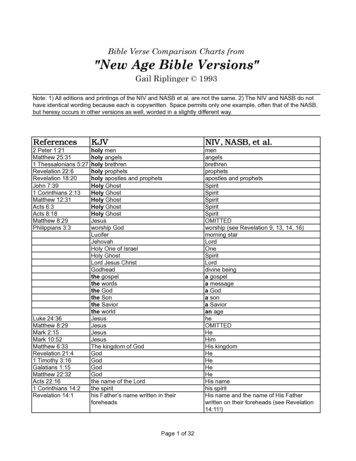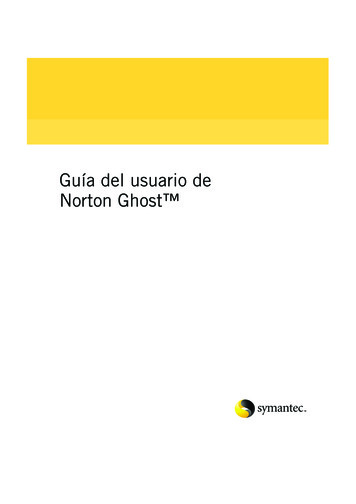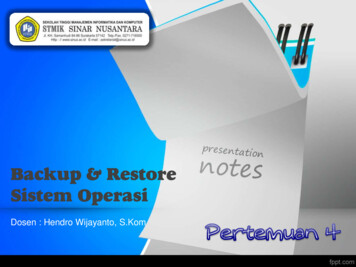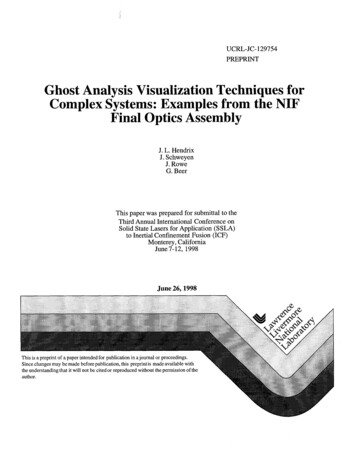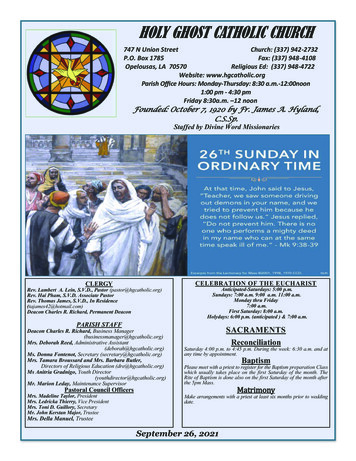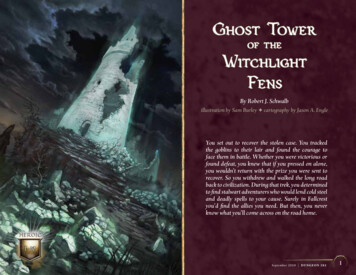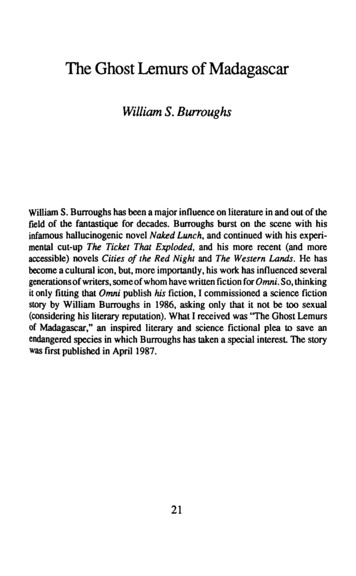
Transcription
The Ghost Lemurs of MadagascarWilliamS. BurroughsWilliamS. Burroughs has been a major influence on literature in and out of thefield of the fantastique for decades. Burroughs burst on the scene with hisinfamous hallucinogenic novel Naked Lunch, and continued with his experimental cut-up The Ticket That Exploded, and his more recent (and moreaccessible) novels Cities of the Red Night and The Western Lands. He hasbecome a cultural icon, but, more importantly, his work has influenced severalgenerations of writers, some of whom have written fiction for Omni. So, thinkingit only fitting that Omni publish his fiction, I commissioned a science fictionstory by William Burroughs in 1986, asking only that it not be too sexual(considering his literary reputation). What I received was ''The Ghost Lemursof Madagascar," an inspired literary and science fictional plea to save anendangered species in which Burroughs has taken a special interest The storywas first published in April 1987.21
The Ghost Lemurs of MadagascarWilliam S. BurroughsThe first name of the libertarian pirate Captain Mission, or Mission, is lost tohistory. All that we know of Mission comes from the book A General Historyof the Most Notorious Pirates, published in London in 1724 and written by oneCaptain Charles Johnson (although one historian attributes this to Defoe). Thememoirs of Mission, handwritten in French, were saved by a member of the crewwho survived Mission's last ship; and after passing through several hands theywere translated by Johnson and included in his book.Mission came from a wealthy Proven family and studied humanity,logic, and mathematics at the University of Angers in the late seventeenthcentury. His fU'St commission was a French man-o'-war called the Victoire,mounting thirty guns and commanded by a distant cousin. They sailed first toNaples, and Mission traveled to Rome, where he met a young priest namedSignor Caraccioli. While Mission was making his confession, he was surprisedto discover the young priest shared his own disgust for the hypocrisy of earthlypower, temporal and spiritual. Caraccioli threw off his frock and signed on to theVictoire.The frigate engaged and defeated two Algerian vessels, Caraccioli receiving a thigh wound. Other engagements were successful. The Victoire crossed theAtlantic, and off Martinique in the Caribbean they were set upon by the EnglishWinclrelsea, commanded by Captain Opium Jones. The fU'St broadside killed thecaptain, second captain, and three lieutenants, whereupon Mission commandedthe men, Caraccioli at his side, and they repulsed the English. Mission was ed captain by the whole crew, and for their pirate flag they raised a whiteenstgn with LIBERTY painted on it. After many other adventures on the Guinea23
THE GHOST LEMURS OF MADAGASCARcoast and West Africa, joined now by a captured English ship and crew, theyhelped the Queen ofJohanna wage war on the neighboring island ofMoheli, bothislands lying between Mozambique and the great red island, Madagascar. Theytook a Portuguese ship and decided to settle down permanently on Madagascar.Here, around 1700 A.D., on a remote harbor at the north end of the island,Mission built two great octagonal forts; and with his band of several hundredFrench and English pirates, renegade seamen, and freed slaves, he establishedthe free colony of Libertatia.Together with his lieutenant Caraccioli and the converted English piratecaptain Thomas Tew, Mission formulated a set of articles by which thesettlement might live in peaceful democracy. These articles were remarkablylike the ideas of Rousseau and the French and American revolutions of the lateeighteenth century-and preceded them by more than sixty years. There wouldbe no capital punishment, no slavery, no imprisonment for debt, and nointerference with religion or sexuality. Signor Caraccioli divided the men intogroups of ten, called States, and the position of Lord Conservator was established, as well as an annual plenary meeting. This flfSt meeting lasted ten days.Tew was made Admiral, Caraccioli Secretary of State, and Mission became HisSupreme Excellence the Lord Conservator.On a cruise off southern Madagascar, Captain Tew and some Englishsailors he had recruited were marooned when they drank rum punch too late onthe last night as the tide rose and carried the noble Victoire out to sea, where shecracked up on the rocks. The crew was lost, and Tew pitched a makeshift campwhere he would wait to be rescued.The word lemur means "ghost" in the native language. There were taboosagainst killing them, and Mission had imposed an article that prohibited thekilling of ghosts, on penalty of expulsion from the settlement If any crimedeserved the death penalty, also prohibited under the articles, then this was thatcrime.He was seeking a different lemur species, described by a native informantas much bigger . like a calf or a little cow."Where are the big ghosts?"The native gestured vaguely inland. "You must be careful of the EvilLizard that changes its colors. If you fall under its spell, you too will changecolors. You too will tum black with anger and green with fear and red with sex.""Well, what is so wrong about that?""In a year you will die. The colors will devour your skin and flesh.""You were talking about a Big Ghost. Bigger than a goat . Where are24
WILLIAM S. BURROUGHSthey?""When you hear Chebahaka, Man-in-the-Trees, then big one not there.Her cannot be where noise is.""Her?""Her He. For Big Ghost is the same.""So him is where Man-in-the-Trees isn't?""No. He is when Man-in-the-Trees is silent." This occurred at dawn andsunset.Captain Mission strapped on his double-barreled flintlock, which he keptloaded with shot charges, and thrust a short sword through his belL He pickedup his staff and walked out through the settlement, stopping here and there to talkto the settlers.They had found an excellent red clay for bricks and were constructing twostory dwellings with second-story balconies supported by heavy hardwoodpillars. These buildings had been joined to form a tier, with the dining andkitchen areas in the two downstairs rooms and the sleeping and dressing areasupstairs. The balconies were connected and were used for sleeping hammocksand pallets. These structures faced the sea, and steps led down to the bay, wherea numberofboats were moored. Mission was heading inland, up a steep path thatleveled off at five hundred feet above the sea. He stopped, leaning on his staff,and looked back. The steep climb had not touched his breath or brought sweatto his face. He saw the settlement, the freshly molded red bricks and thatchalready timeless as houses in fairyland. He could see the shadows under the pier,the lurking fish, the clear blue water of the bay, the rocks and foliage, all floatingin a limpid, frameless painting.Silence descended like a shroud that would crumble to dust when hemoved. Now a cat 's-paw of wind frisked across the bay and up through the ferns,bringing to his face a breath of panic. Little ghost paws rippled up his spine,stirring the hairs at the nape of his neck, where the death center flares brieflywhen a mortal dies.Captain Mission did not fear panic, the sudden, intolerable knowing thateverything is alive. He was himself an emissary of panic, of the knowledge thatman fears above all else: the truth of his origin. It's so close. Just wipe away thewords and look.He moved through giant ferns and creepers in green shade without needof his cutlass and stopped on the edge of a clearing. A moment of arrestedmotion, then a bush, a stone, a log moved as a bibe of ring-tailed cat lemursai Peared, parading back and forth around one another, tails quivering abovetheir heads. Then whisk-they were gone, drawing the space where they had25
THE GHOST LEMURS OF MADAGASCARbeen away with them. In the distance he could hear the cries of the sifaka lemurthe natives called Chebahaka, Man-in-the-Trees. With a quick motion he caughta grasshopper and knelt by a moss-covered log. A tiny face with round eyes andlarge, trembling ears peered at him nervously. He held out the grasshopper, andthe little mouse lemur fell upon it with chirping squeaks of delight, holding it inhis tiny paws and nibbling quickly with his tiny needle teeth.Mission moved toward the sound, which was louder and louder. TheChebahakas saw him and let out a concerted shriek that pierced his eardrums.Suddenly the sound stopped, with an impact that threw him to the ground. He layfor some minutes in a half faint, watching the gray shapes swing away throughthe trees.Slowly he rose to his feet, leaning on his staff. Before him stood an ancientstone structure, overgrown with creepers and green with moss. He steppedthrough an archway, stone slabs under his feet. A large snake, of a glisteningbright green, glided down the steps leading to a basement room. Cautiously hedescended to an underground room. At the far end an arch opened to admit theafternoon light, and he could see the stone walls and ceiling.At the end of the room was an animal that looked like a small gorilla or achimpanzee. This surprised him, since he had been told there were no truemonkeys on the island. The creature was motionless and black, as if formed outof darkness. He saw also a large pig creature of a light pink color,lolling on itsside against the wall to his right. Then, directly in front of him, he saw an animalthat looked at fJrSt like a small deer. The animal came to his outstretched hand,and he saw that it had no horns. Its snout was long, and he glimpsed sharp teethshaped like little scimitars. The long, thin legs ended in cablelike fingers. Theears were large, flaring forward; the eyes, limpid amber in which the pupilfloated like a glittering jewel, changing color with shifts of the light: obsidian,emerald, ruby, opal, amethyst, diamond.Slowly the animal raised one paw and touched his face, stirring memoriesof the ancient betrayal. Tears streaming down his face, he stroked the animal'shead. He knew he must get back to the settlement before dark. There is alwayssomething a man must do in time. For the deer ghost there was no time.Faster and faster downhill, tearing his clothing on rocks and thorny vines.by dusk he was back at the settlement He knew at once that he was too late, thatsomething was horribly wrong . No one would meet his eye. Then he saw BradiYMartin, standing over a dying lemur.Mission could see that the lemur had been shot through the body. He felta concentration of rage, like a hot, red wave, but there was no reciprocal angerin Martin.26
WILLIAM S. BURROUGHS"Why?" Mission choked out."Stole my mango," Martin muttered indifferently.Mission's hand flew to the butt of his pistol. Martin laughed. "You wouldviolate your own article, Captain?""No. But I will remind you of Article Twenty-three: If two parties have adisagreement that cannot be settled, then the rule of the duel is applicable.""Aye, but I have the right to refuse your challenge, and I do." Martin wasan indifferent swordsman and a poor pistol shot."Then you must leave Libertatia, this very night, before the sun shall setYou have no more than an hour."Without a word, Martin turned away and walked off in the direction of hisdwelling. Mission covered the dead lemur with a tarpaulin, intending to take thebody into the jungle and bury it the following morning.In his quarters Mission was suddenly overcome by a paralyzing fatigue.He knew that he should follow Martin and settle the matter, but-as Martin hadsaid-his own articles . He lay down and fell immediately into a deep sleep.He dreamed that there were dead lemurs scattered through the settlement, andwoke up at dawn with tears streaming down his face.Mission dressed and went out to get the dead lemur. The lemur and thetarpaulin were both gone. With blinding clarity he understood why Martin hadshot the lemur and what he intended to do: He would go to the natives and saythat the settlers were killing the lemurs and that when he objected, they turnedon him and he had barely escaped with his life. Lemurs were sacred to the nativesin the area, and there was the danger of bloody reprisal.In a prerecorded and therefore totally predictable universe, the blackest sinis to tamper with the prerecordings, which could result in altering the prerecorded future. Captain Mission was guilty of this sin. He threatened to demonstrate for all to see that three hundred souls can coexist in relative harmony witheach other, their human neighbors, and the ecosphere of flora and fauna. Big Benstrikes the hour. In a muted, ghostly room, the custodians of the future convene.Keepers of the Board Books: Mektoub, it is written. And they don't want itchanged."If three hundred men-then three thousand, thirty thousand. It couldspread everywhere. It must be stopped now.""Our man Martin is on target. He is quite reliable.". A woman leans slightly forward. An arresting face of timeless beauty ande':I1, an evil that stops the breath like a deadly gas. The chairman covers his faceWith a handkerchief. She speaks in a cold, brittle voice, each word a chip of27
THE GHOST LEMURS OF MADAGASCARobsidian: ''There is a more significant danger. I refer to Captain Mission'sunwholesome concern with lemurs." The word slithers out of her mouthwrithing with hatred.Mission had smoked opium and hashish and had used a drug the Indiansof South America called yage. There must, he decided, be a special drug peculiarto this huge island, where there are so many creatures and plants not foundanywhere else. After some inquiries he found that such a drug did exist: It wasextracted from a parasitic fungus that grew only on a certain spiny plant foundin the arid regions of the south. The drug was called indris, which means lookthere in the native language. With the promise of five gold florins on delivery,he obtained a small supply from a friendly native. The drug was in the form ofgreenish-yellow crystals. The man, whose name was Babuchi, showed himexactly how much to take and cautioned him against taking any more."Many take indris and see nothing different Then they take more and seetoo much different""Is this a day drug or a night drug?""Best at dawn and twilight."Mission calculated an hour till sundown-enough time to reach his junglecamp. "How long does it take to work?""Very quick."Mission set out walking rapidly. Half an hour later, he took a small amountof the crystals with a sip of water from his goatskin water bag. In a few minuteshe experienced a shift of vision, as if his eyes were moving on separate pivots,and for the first time he saw Lizard-Who-Changes-Color. It was quite large,about two feet in length, and difficult to see, not because it took on the colors ofits surroundings but because it was absolutely motionless. He moved closer tothe lizard, who brought one eye to bear on him and turned black with rage.Evidently Lizard-Who-Changes-Color did not like to be seen. His colorssubsided to a neutral orange-yellow, mottled brown. And there was a gurkhalizard on a limb, as if carved from the bark. He winked a golden eye at Mission.Despite the need for vigilance, Mission was spending more and more timein the jungle with his lemurs. He had converted the ancient stone structure he hadfound into a dwelling. It was completely enveloped by the roots of a huge,bulbous tree, as if held in a giant hand. The open arch in the second room wasfestooned with roots. There was a paved floor. He had covered the entrance withmosquito netting and arranged a pallet on the floor. Brushing the floor, he wassurprised to find few insects, certainly no venomous varieties. The stone stepswere worn smooth, as if with the passage of many feet, perhaps not human feet.28
WILLIAM S. BURROUGHSWho, or what, could have built this structure, and for what purpose?Since his ftrSt encounter he had located a troop of the larger lemurs. Theselemurs were too big and heavy to be comfortable in arboreal conditions and livedmostly on the land, in an area of grass and scrub where the forest thinned out, amile from his campsite. Ideal grazing land, Mission realized with a shudder. Thecreatures were so trusting and gentle and open to human affection. Missionhurried on. He wanted to reach the ancient stone structure before twilight, andhe hoped his special lemur would be there. He often slept with the lemur besidehim on his pallet, and had named the lemur Ghost.As he walked up, Ghost gave a little chittering cry of welcome. Missiontook off his boots and hung his outer garments on wooden pegs driven intochinks in the stone wall. The only furniture was a table of rough hewn plankssupported on two logs, with an inkpot, quill, pens, and parchment In one comerwas a small keg with a spigot for water, some cooking utensils, an ax, a saw,hammers, a musket. Powder and shot were kept in the footlocker. Mission sat atthe table beside his phantom, his Ghost, contemplating the mystery of the stonestructure. Who could have built it? Who?He poses the question in hieroglyphs . a feather . he chooses a quillpen. Water . the clear water under the pier. A book . an old illustrated bookwith gilt edges. The Ghost Lemurs of Madagascar. Feather . a gull diving forgarbage . the wakes of many ships in many places. A feather of the great birdthat lived here once, and the sacred lake two days' walk west, where every yeara heifer is sacrificed to a sacred crocodile. Still the who? eludes him. He wondersif there are other, similar structures on the island. Where?A loaf of bread . water . a goose tied to a stake. Looking through theeyes of Lizard-Who-Changes-Color from one end of the island to the other. Theappalling answer comes back: nowhere, none. Why appalling? He doesn't knowyet, but he knows. When?A reed . a loaf of bread . a bird wheels in the sky. A woman plucksfeathers from a fowl, takes a loaf of bread from an adobe oven. The split betweenthe wild, the timeless, the free, and the tame, the time-bound and binding, thetethered, like the tethered goose of where? The tethered who will forever resenttheir bondage.The structure was built at the one time it could have been built, before thesplit widened to an impassable chasm.The concept of a question is reed and water. The question mark fades intoreeds and water. The question does not exisLStrange creatures are fitting stones together. He can't see them clearly,only their hands, like gray ropes. He senses the immense difficulty of an29
THE GHOST LEMURS OF MADAGASCARunaccustomed task. The stones are too heavy for their hands and bodies. Yet forsome reason they must build this structure. Why?There is no why. Mission is there. Look there.Ghost stirred beside him and belched a sweet scent of tamarind fruit.Despite Babuchi's warning, Captain Mission knew he must learn more.He lit a candle and poured a very large dose of indris crystals into his handand downed them with a cup of water. He remembered the dream gorilla in thebasement room, the strange pig creature, and then the gentle deer lemur. Missionlay down by his Ghost He wasn't sure he wanted to see what the indris wouldshow him, knowing that what he saw would be sad beyond his endurance. Helooked out through tree roots as night sopped up the remaining light like a vast,black sponge.He lay there in the gray light, his arm around his lemur. The animalsnuggled closer and put a paw up to his face. Tiny mouse lemurs stole out of theroots and niches and holes in the ancient tree and frisked around the room, fallingon insects with little squeals. Their tails twitched above their heads; their greatflaring ears, thin as paper, quivered to every sound as their wide, limpid eyesswept the walls and floors for insects. They have been doing this for millions ofyears. The twitching tail, the trembling ears mark the passage of centuries. Thelittle squeak of triumph was heard before the birth of man.As the light drained into the sponge of night, the room grew ever brighter.He could see for miles in every direction: the coastal rain forests, the mountainsand scrub of the interior, the arid southern regions where the lemurs frisk in thetall, spiny cactus. They gambol, leap, and whisk away into a remote past beforethe arrival of man on this island, before the appearance of man on Earth, beforethe beginning of time.An old picture book with gilt-edged lithographs, onion paper over eachpicture. The Ghost Lemurs of Madagascar in gold script. Giant ferns andpalms, bulbous tamarind trees, vines, and bushes. In a comer of the picture is ahuge bird, ten fat feet high, a plump, dowdy, helpless bird, obviously flightlessnever get that off the ground. This bird tells one that here is a time pocket. Therecan be no predators in this forest, no large cats. In the middle of the picture is aring-tailed lemur on a branch looking straight out at the viewer. Now morelemurs appear, like a picture puzzle.The Lemur People are older than Homo sap, much older. They date backsixty million years to the time when Madagascar split off from the mainland ofAfrica. They might be called psychic amphibians-that is, visible only for shortperiods when they assume a solid form to breathe, but some of them can remain30
WILLIAM S. BURROUGHSin the invisible state for years at a time. Their way of thinking and feeling isbaSically different from ours, not oriented toward time and sequence andcausality. They fmd these concepts repugnant and difficult to understand.One might think that a species that leaves no fossil record is gone forever,but Big Picture, the history oflife on Earth, is there for anyone to read. Mountainlandmasses and jungles glide past, some slowing, some accelerating, vast riversof land on the move or stagnating in wide deltas, whirlpools of land like sawssplitting off islands, a great fissure, the landmasses rubbing against each other,then splitting, flying apart faster and faster . slowing down to the great redisland, with its deserts and rain forests, scrub mountains and lakes, its uniqueanimals and plants and the absence of predators or venomous reptiles, a vastsanctuary for the lemurs and for the delicate spirits that breathe through them,the glint in the jeweled eyes of a tree frog.Above the wild time of Moving Lands, whole continents gliding past eachother, gathering silent speed like trains; and any enterprising young man couldget a few acres on the move and join up with other folks-going our way? Therewere accidents aplenty, volcanoes and earthquakes of every magnitude, plugs ofmolten rock suddenly thrown into the air, and vast, steaming sump holes andboiling lakes.When attached to Africa, Madagascar was the ultimate landmass, stickingout like a disorderly tumor cut by a rift of future contours, a long rift like a vastindentation, like the cleft that divides the human body. The rift is a mile acrossin places, and in others narrows down to a few hundred feet. It is an area ofexplosive change and contrast, swept by violent electrical storms, incrediblyfertile and yet barren. The frrst People of the Rift were a race apart, frenziedentrepreneurs."These prices is too good to last, folks!"An ominous tremor shakes the bargaining table.The People of the Cleft, formulated by chaos and accelerated time, flashthrough sixty million years to the split. Which side are you on? Too late to changenow. Separated by a curtain of frre. Like a vast, festive ship launched byfueworks, the great red island moved majestically out to sea, leaving a gapingwound in the earth s side, bleeding lava and spurting noxious gases. It has lainmoored in enchanted calm for sixty million years.Time is a human affliction. Not a human invention but a prison. So what is eaning of sixty million years without time? And what does time mean toboragtng lemurs? No predators here, not much to fear. They have opposing thumbsu do not fashion tools: They have no need for tools. They are untouched by theevd that flows in and fills Homo sap as he picks up a weapon-now he has the:e31
THE GHOST LEMURS OF MADAGASCARadvantage. A terrible gloating feeling comes from knowing you've got it!Lemurs don't need iL Six minutes, sixty million years-no difference.Nothing is happening. A feeling of desolation closes round the human essenceat the thought. How long have the lemurs paraded before each other in their sadand perfect beauty? How long have the singing gibbons sung their timeless song,as little gibbons clinging to their backs attempted to sing too?Beauty is always doomed. "The evil and armed draw near." Homo sapwith his weapons, his time, his insatiable greed, and ignorance so hideous it cannever see its own face."Justlet me club down some seal pups, cut an Injun'shands off, bum a Nigra's balls off and watch 'em pop, then we'll all feel a lotbetter."These are unsightly tricks."Whaddaya think this is, a beauty contest?"A lemur frisks toward the man, and he slashes it viciously, leaves itbleeding, sobbing, dying. ''Try and bite me, will you . fucking animals!"Man was born in time. He lives and dies in time. Wherever he goes, hetakes time with him and imposes time.Captain Mission was drifting out faster and faster, caught in a vastundertow of time. "Out, and under, and out, and out," a voice repeated in hishead .Erase the concept of a question from your mind. The Egyptian glyph is areed or feather and water. The question dissolves in reed and water as a poetwrites on water. Who? The water the feather the book. Wipe it out with thesquawking goose of where and the bread of when, fading into a great, extinct,flightless bird in a swampy pool.Mission knows the stone temple is the entrance to the biological Gardenof Lost Chances. Pay and enter. He feels an impact of sadness that stops hisbreath, a catching, tearing grief. This grief can kill. He is beginning to learn thecoinage here.He remembers the pink pig creature, lost in passive weakness, slumpedhopelessly against the wall, and the black simian against the far wall by theentrance, very still and very black, a blackness that glows. And the gentle deerlemur, extinct for two thousand years, the Ghost that shares his pallet. He movesforward through the roots that trail from the ancient stone arch. Somehow theblack monkey creature is in front of him, and he looks into his eyes, completelYblack. He is singing a black song, of a blackness too pure to survive in time. Itis only compromise that survives, and that is why Homo sap is such a muddled.32
WILLIAM S. BURROUGHSunsightly creature, precariously and hysterically defending a position that heIcnows is hopelessly compromised.Mission moves through a black tunnel, opening on a series of dioramas:'The last deer lemur falls to a hunter's arrow. Passenger pigeons rain from thetrees to salvos of gunfire and plump down on the plates of fat bankers andpoliticians with their gold watch chains and gold fillings. They belch out the lastpassenger pigeon. The last Tasmanian wolf limps through a blue twilight, legshattered by a hunter's bullet. And the almosts, the might-have-beens, who hadone chance in a billion and lost. Seeing the planet as an organism, it is obviouswho the enemies of the planet are. Their name is legend. They dominate andpopulate the planet ''The deceived and the deceivers who are themselvesdeceived." Did Homo sap think other animals were there just for Him to eal?Apparently. Bulldozers are destroying the rain forests, the cowering lemurs andthe flying foxes, the singing Clos gibbons, who produce the most beautiful andvariegated music of any land animal, and the gliding colugo lemurs, who arehelpless on the ground. All going, to make way for more and more devaluedhuman stock, with less and less of the wild spark, the priceless ingredientenergy into matter. A vast mud slide of soulless sludge.Doom and sadness hangs with the gray mist in these damp cages. It's therein every face, and any kid cracks up and starts screaming I CAN'T STAND ITwill get slapped by John Wayne. It's Zoo City here. Strange dream animals roamthe ghost midways and sideshows. Margams slinks into the White Cat bar"Seen any black cats lately?"-"Not lately, Whitey, they all got bleached outlike you, got the light inside, you might say, and they lit up with a pure whiteflame. Wasn't nothing I could do to prevent it."Margaras turns up the silvery light, the silvery white light, searingmoonlight flooding in shredding flesh to silver film flakes-let go and let ithappen, let yourself flake on out flake on out like snow it's all raining downbehind you all your past life breaking loose and raining down in chunks ofmalevolence and joy and fear and the pure killing purpose, little scenes like soapbubbles bursting in air. Whose flag was still where? Everything is fading, fallingto pieces behind you as you move and now ahead of you as well-where whoare you? Who were you why? It has no reality, it leaves nothing behind save theobserver. Observe the observer observed. As indris can give eyes to see another reality, it can also, in the hands ofa skilled sorcerer, impose tunnel vision in his native victims: "A man appearedand id they were bad people and had to be killed." While Captain Tew waitedat h s lonely, distant cove. In the dead of night two huge bands of Malagasy33
THE GHOST LEMURS OF MADAGASCARnatives swept down upon Libertatia and wiped out the colony. LieutenantCaraccioli died in this attack, and Mission escaped with only fony-five men andtwo sloops. In time he found his way to Captain Tew's remote harbor, and thetwo men decided to retire to America, where they were both unknown. In a greatstorm off Cape Infantes, Captain Mission's sloop was lost beneath the waves.Author's note: Now, in 1987, the lemurs of Madagascar are threatenedwith extinction. When humans frrst arrived on the island 1,500 years ago, therewere some 40 species; now only 22 remain, and all are considered endangered.In some pans of the island the natives hunt the s
bringing to his face a breath of panic. Little ghost paws rippled up his spine, stirring the hairs at the nape of his neck, where the death center flares briefly when a mortal dies. Captain Mission did not fear panic, the sudden, intolerable knowing that everything is alive. He was himself an emissary of panic, of the knowledge that


